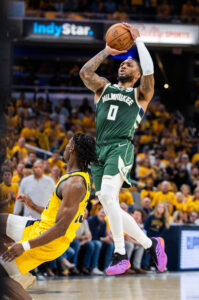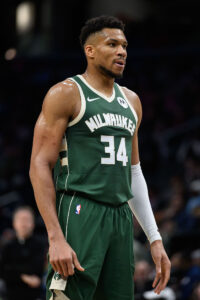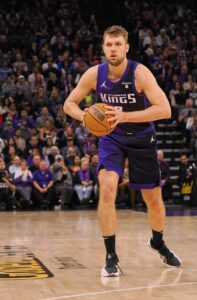Several of the core contributors who played key roles during the Bucks‘ championship run in 2021 – including Giannis Antetokounmpo, Khris Middleton, Brook Lopez, Bobby Portis, and Pat Connaughton – have remained on the roster since then, but the team has struggled to replicate the success of that season.
After being bounced in the second round of the 2022 playoffs, the top-seeded Bucks were upset by the No. 8 Heat in the first round in 2023. Determined not to get complacent following that disappointing outcome, Milwaukee made two major changes last offseason, firing head coach Mike Budenholzer and replacing him with first-time head coach Adrian Griffin in the spring, then packaging Jrue Holiday, Grayson Allen, a future first-round pick, and a pair of first-round swaps for seven-time All-Star Damian Lillard just before training camp got underway.

To say the results were mixed would be generous. Griffin opened the season with a strong 30-13 (.698) record, but Milwaukee never seemed to be firing on all cylinders during that stretch, and the Bucks’ veteran players were reportedly questioning the new coach’s schemes, especially on defense. Griffin was replaced just halfway through his first season by Doc Rivers, with Bucks general manager Jon Horst citing Rivers’ championship experience and leadership as a better fit for the veteran roster.
Lillard, meanwhile, earned his eighth All-Star nod and led the Bucks with 7.0 assists per game, but his scoring average (24.3), field goal percentage (42.4%), and three-point percentage (35.4%) were all below his career rates and he didn’t mesh with Antetokounmpo quite as seamlessly as the club had hoped.
The addition of a gifted scorer and play-maker like Lillard to the roster helped Milwaukee improve its offensive rating from 15th in 2022/23 to sixth in ’23/24, but the loss of talented defenders like Holiday and Allen hurt. The Bucks’ defensive rating plummeted from fourth to 19th, bumping the club’s overall net rating from fifth down to 11th.
For a second straight year, the Bucks lost in the first round of the playoffs as the higher seed while Antetokounmpo dealt with an injury. After missing two-and-a-half games in the 2023 series vs. the Heat, Giannis was unavailable for the entire Eastern Conference quarterfinal vs. Indiana this spring. Without the two-time MVP – plus Lillard, who missed Games 4 and 5 – Milwaukee couldn’t keep up with the Pacers.
While there’s optimism that a full offseason with Rivers and Lillard will create more cohesion heading into the 2024/25 season, it’s hard to feel all that bullish about the Bucks’ championship potential with the current roster, based on how the last two years have played out. But barring cost-cutting moves, the club once again projects to operate over the second tax apron, limiting the front office’s options for pursuing upgrades, so better chemistry and better health luck may be Milwaukee’s best hopes for another deep playoff run.
The Bucks’ Offseason Plan
With a roster this expensive, it’s logical to wonder if any of the Bucks’ four highest-paid players could be on the move this summer. However, it seems safe to assume the team won’t be looking to move Antetokounmpo or Lillard.
Middleton, meanwhile, has been affected by injuries over the past two years, but he looked like his old self in the playoffs this spring, averaging 24.7 points, 9.2 rebounds, and 4.7 assists per game on .482/.355/.900 shooting vs. the Pacers despite receiving more defensive attention with Giannis out. If the Bucks are relatively confident they’ll get that version of Middleton going forward, as he enters his age-33 season, it doesn’t make sense to trade him.
That leaves Lopez, who will earn $23MM in his age-36 season. Those two numbers look a little scary alongside one another, but Lopez is only a year removed from finishing second in Defensive Player of the Year voting and remains the kind of center every team is seeking — one who can space the floor on offense (he has a .369 3PT% over the past three seasons) and protect the rim on defense (2.3 BPG during that same three-year stretch). He’d certainly have positive trade value on his expiring contract, but it’s hard to see how moving him would make Milwaukee better.
The average age of the four-man core is somewhat concerning (only Antetokounmpo will be younger than 33 next season), but I’d be surprised if the Bucks don’t roll with that group for at least one more season. A year from now, with Lopez’s contract expired and Middleton facing a player option decision for 2025/26, the team will be in a better position to reassess its options.
Portis is one of the league’s best sixth men and is a relative bargain at $12.6MM, so he’ll almost certainly stay put too, leaving the Bucks to fill out the rest of the roster with players who can complement that strong top five.
That collection of complementary players could start with Connaughton, though his production has taken a hit since he enjoyed a career year in 2021/22 — he has averaged just 6.5 points per game on .411/.341/.717 shooting over the past two seasons. I expect the Bucks to explore the trade market to see if there’s a way to turn his $9.4MM contract into one or two more reliable role players (or one lesser-paid player and cap/tax relief), but they don’t have many draft assets left to attach to him to sweeten their offers.
Every single one of Milwaukee’s draft picks from 2025-30 has either been traded or is tied up in a swap. The team’s 2031 picks can be traded beginning in July, so either the first- or second-rounder (or both) could be packaged with Connaughton in an effort to find an upgrade. Under normal circumstances, I’d suggest the Bucks may prefer to preserve the 2031 first-rounder for a more significant move, but they’re so all-in on this team in the short term that they probably shouldn’t hang onto that pick too tightly if there’s a deal out there that clearly makes them better.
In order to fill out the rest of the rotation beyond their top six or seven players, there are only two real paths available to the Bucks: Signing veteran free agents and continuing to add and develop young talent. Let’s start with free agency.
Assuming they’re not able to shed salary, the Bucks will generally be limited to minimum-salary signings as a second-apron team (they’ll be able to offer most of their own free agents 20% above the minimum). Players unable to do better than that on the open market will certainly have interest in Milwaukee, since the team is a potential contender and will likely have rotation spots available.
Still, the minimum-salary pool is a limited one. Malik Beasley was a nice addition for the minimum last summer and I’m sure the Bucks would love to have him back, but he may draw interest at a higher price point than what Milwaukee can offer. The rest of the club’s free agents are probably once again in line for minimum deals, at best, so they’re candidates to be brought back, though there are red flags in each case.
Patrick Beverley‘s year came to an ugly end due to an incident with Indiana fans that resulted in a four-game suspension to open the 2024/25 season; Jae Crowder and Danilo Gallinari are in their mid-30s and aren’t the players they once were; Thanasis Antetokounmpo has a torn Achilles that will likely cost him most – if not all – of ’24/25. Of those four, Beverley would be the most useful on-court fit, if the Bucks are willing to give him another chance following his end-of-season meltdown.
As the Bucks explore the market for outside free agents, they could use another point guard, wing, and center. Jordan McLaughlin and Aaron Holiday are potential under-the-radar targets at the point; Justin Holiday and Cedi Osman would be intriguing options on the wing if they’re available for the minimum; Daniel Theis and Xavier Tillman are a couple options I like at center.
Milwaukee also has a handful of young players on team-friendly contracts and will have to determine whether they remain committed to MarJon Beauchamp, A.J. Green, Andre Jackson, and Chris Livingston. None of those four players logged more than 614 minutes last season, but they showed some promise, with Beauchamp, Green, and Jackson all shooting the ball well. Rivers isn’t exactly known as a player-development specialist, but if those youngsters continue to make strides, there should be room in the rotation for at least one or two of them.
If the Bucks are concerned about their luxury tax bill and their proximity to the aprons, Beauchamp would be the most logical trade candidate of that quartet, since his fully guaranteed salary of $2.73MM is the only one above the minimum — the team could save some money by swapping him out for a minimum-salary replacement.
The Bucks will also enter this year’s draft armed with the 23rd and 33rd overall picks, putting them in a good position to nab at least one player who could contribute immediately. This draft class isn’t top-heavy, but it has no shortage of seasoned college players who spent three, four, or five seasons at school and who should be able to transition to the NBA more smoothly than the average one-and-done prospect. That could work just fine for Milwaukee.
It wouldn’t shock me if the Bucks look to move down from No. 23 unless there’s a specific player they love at that spot. Trading that pick for a 2024 second-rounder and maybe a couple future second-rounders would help them begin to restock a bare cupboard of future draft assets and would be financially advantageous — a second-round pick would likely only count toward the cap and tax for approximately $1.16MM, whereas the 23rd pick would have a starting salary of about $2.95MM.
Marquette’s Tyler Kolek, Creighton’s Baylor Scheierman, Dayton’s DaRon Holmes II, Cal’s Jaylon Tyson, and Kansas’ Kevin McCullar are a few of the prospects who spent at least three years at college and who should be available late in the first round or early in the second for the Bucks.
Salary Cap Situation
Guaranteed Salary
 Giannis Antetokounmpo ($48,787,676)
Giannis Antetokounmpo ($48,787,676)- Damian Lillard ($48,787,676)
- Khris Middleton ($31,666,667)
- Middleton’s cap hit includes a $31,000,000 base salary and $666,667 in likely incentives.
- Brook Lopez ($23,000,000)
- Bobby Portis ($12,578,286)
- Pat Connaughton ($9,423,869)
- MarJon Beauchamp ($2,733,720)
- Chris Livingston ($1,891,857)
- Andre Jackson ($945,929)
- Partial guarantee. Rest of salary noted below.
- Total: $179,815,680
Non-Guaranteed Salary
- A.J. Green ($2,120,693)
- Green’s salary will become guaranteed if he remains under contract through July 8.
- Andre Jackson ($945,928)
- Partial guarantee. Rest of salary noted above.
- Jaylin Galloway (two-way)
- Ryan Rollins (two-way)
- Total: $3,066,621
Dead/Retained Salary
Player Options
Team Options
Restricted Free Agents
Two-Way Free Agents
Note: Because he’s a former first-round pick who had his third- and/or fourth-year option declined, Washington will be an unrestricted free agent.
Draft Picks
- No. 23 overall pick ($2,951,760 cap hold)
- No. 33 overall pick (no cap hold)
- Total (cap holds): $2,951,760
Extension-Eligible Players
- Pat Connaughton (veteran)
- Bobby Portis (veteran)
Note: Unless otherwise indicated, these players are eligible for extensions beginning in July.
Unrestricted Free Agents
- Thanasis Antetokounmpo ($2,093,637 cap hold): Bird rights
- Malik Beasley ($2,093,637 cap hold): Non-Bird rights
- Patrick Beverley ($2,093,637 cap hold): Non-Bird rights
- Jae Crowder ($2,093,637 cap hold): Bird rights
- Danilo Gallinari ($2,093,637 cap hold): Non-Bird rights
- Total (cap holds): $10,468,185
Other Cap Holds
Note: The cap holds for these players are on the Bucks’ books from prior seasons because they haven’t been renounced. They can’t be used in a sign-and-trade deal.
Cap Exceptions Available
Note: The Bucks project to operate over the cap and over the second tax apron. That means they won’t have access to the mid-level exception, the bi-annual exception, or either of their two existing trade exceptions. If they dip below the second apron, they would gain access to the taxpayer mid-level exception ($5,183,000).
 An
An 
